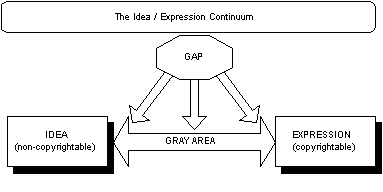
Dueling dentists. - Whelan v. Jaslow
Dental Prosthetics and Software
Whelan developed and distributed a program for managing dental labs. Jaslow Dental Lab made dental prosthetics. After some interaction with Whelan, Jaslow also developed and distributed a program for managing dental labs. Whelan felt that Jaslow's program was too similar to her program, and accused Jaslow of copying the non-literal structure of her copyrighted dental lab management program. As it happens, Jaslow's software contained identical copies of most of Whelan's file structures, screen output, and modules.
The Idea / Expression Continuum

In assessing infringement, the Court devised a new test for determining the gap between idea (which cannot be protected by copyright) and expression (which can be protected by copyright). The court decided that the purpose or function of a utilitarian work, such as a computer program, is the work's idea, and that everything not necessary to that purpose or function is part of the expression of the idea. Where there are various means of achieving the purpose or function, the means chosen are not necessary and therefore constitute expression. With this rule, the court held that copyright in a computer program protects the non-literal structure, sequence and organization of that program. Consequently, copyright infringement could be found for these elements even in the absence of direct source code or object code copying.
Extension of Copyright Protection for Software
By using the Continuum, the Court found copyright infringement based upon Jaslow's copying of the "structure, sequence and organization" of Whelan's software. While recognizing that copyright protection does not extend to the "idea" or functionality of the program, the Court found that similarities in the file structures, screen outputs and certain subroutines, while not comprising a majority of the total number of lines of code in defendant's software, were similarities in "expression," and therefore constituted copyright infringement.
The Court summarized its Idea / Expression Continuum Discernment Test for determining the line between unprotectable ideas and the protectable expression of those ideas as follows:
"the line between idea and expression may be drawn with reference to the end
sought to be achieved by the work in question. In other words, the purpose
or function of a utilitarian work would be the work's idea, and everything that
is not necessary to that purpose or function would be part of the expression of
the idea."
The Court thereby extended copyright protection beyond literal copying of the program code itself, and included the structure, sequence, and organization of the code. The Court further extended copyright protection for software with its Idea / Expression Continuum Discernment Test, a broad test which limited unprotectable "ideas" to only those "necessary to the program's purpose or function" and everything else is or could be protectable expression.